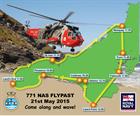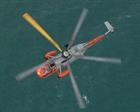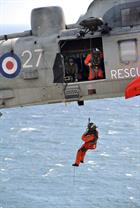771 NAVAL AIR SQUADRON CELEBRATE 76TH ANNIVERSARY FLYPAST
Royal Naval Air Station Culdrose based 771 Naval Air Squadron (Search and Rescue) will undertake an aircraft formation flypast around iconic Cornish locations to acknowledge their 76th anniversary.
771 NAS was commissioned on 24th May 1939 initially at Lee on Solent but moved toPortlandas a Fleet Requirements Unit (Trials and Evaluation) with 14Fairey Swordfish biplanes. During the Second World War one of their most notable actions took place whilst the Squadron was based at RNAS Hatston (HMS Sparrowhawk) in the Orkneys. Ordered to identify and sink the German Battleship Bismarck at the earliest opportunity. The CO RNAS Hatston had at his disposal two squadrons of Albacores and was relying on RAF Coastal Command aircraft to spotBismarck’s movements fromBergeninNorway.
On 22 May 1941 Coastal Command deemed the weather unsuitable for flying but despite this a crew from 771 NAS was assembled and readied one of their twin engineMarylandaircraft, for action. Piloted by Lieutenant Noel Goddard they flew much of the mission on instruments at very low level over the sea, making landfall near to the target. Confirming that she was breaking out into the Atlantic, the four man crew reported thatBismarckhad leftBergen. Attempting to radio their discovery back to Coastal Command, they received no reply. The mission Commander and Observer, Commander Geoffrey Rotherham decided to alert the Air Station directly with their Towed Target frequency and also fly directly to Sumburgh, RNAS Hatston’s forward airfield, where the Albacores were ready to intercept. Acting on this message, the Home Fleet set sail and engageBismarck, intercepting her at theBattleof the Denmark Straits. On 16 September 1941 The London Gazette reported the awarding of the following honours:Rotherhamreceived the DSO, Goddard the DSC and Leading Airman Armstrong the DSM. Goddard went on to Command 771 NAS as a Temporary Lieutenant Commander (A) on 15 October 1941.
In February 1945, 771 received the Hoverfly, making it the first Naval Squadron to operate helicopters, which it used until May 1947. Throughout the war and in the early 50’s the Squadron flew many varied aircraft including Martinets, Bostons, Corsairs, Wildcats, Oxfords, Hellcats, Seafires, Harvards, Mosquitos, Sea Furies, Sturgeons, as well as the Hoverfly.
Disbanding in Aug 1955 they were re-commissioned in Jul 1961 with a mixture of Dragonfly and Whirlwind Helicopters atPortlandonce again, as a helicopter trials Unit. Another role for the squadron was the Search and Rescue commitment forPortland. The Squadron again disbanded in Dec 1964when they were absorbed into 829 NAS, but were back again in Jun 1967 equipped with nine Whirlwind Mk 7’s. Their role was primarily that of an Anti-Submarine Fleet Requirements Unit, but it also acted as the station SAR Flight.
The Westland Wessex Mk 1 was introduced in Nov 1969 and on 04Sept 1974, 771 NAS moved to RNAS Culdrose, taking on Aircrewmen training as well as the Station SAR Flight. This marked the beginning of a long association with theWessex. By 1970, the ASW role had been passed on to its sister squadron, 737 NAS making SAR 771's primary role, a role that has remained to the present day. The Wessex Mk 1 was replaced by the twin turbine-powered Wessex Mk 5 in 1979, when it was involved with the 1979 Fastnet race rescues. During the Falklands Conflict in 1982 all of 771 aircraft were taken up for troop transport roles, some sent to 722 NAS at Portland but the majority reformed 847 & 848 NAS along with some of it’s aircrew.
The remaining went either to their old aircraft type, or to new roles in the Lynx or Wasp helicopter fleets. Post Falklands in Aug 1982 the squadron began to receive back itsWessexto form the nucleus of 771 NAS as it took back the SAR commitment from the RAF.
In January 1983 the Squadron once again operated mixed fleets of rotary and fixed wing aircraft as it absorbed the Station Flight, taking ownership of two Chipmunks and two Sea Devons. It operated these until the end of 1989 when the Sea Devon was withdrawn from service. In 1985 the Squadron absorbed 707 NAS Wessex helicopters taking over the Commando Helicopter Training as well. TheWessexwas replaced by Sea King Mk 5 in October 1987 as it assumed a long range, day and night all weather SAR capability. In July 2001, 771 Squadron took the responsibility for Advanced and Operational Flying Training of Anti-Submarine Warfare (ASW) Pilots and Observers, as well as the residual Sea King Mk 5 & Mk 6 pilot conversion and refresher courses.
Today the Squadron only operates the Sea King Mk 5 in its distinctive red and grey colours stationed at RNAS Culdrose. Its sister unit, Gannet Flight operates three Sea Kings performing a similar role from HMS Gannet at Prestwick Airport in Scotland.
Their primary role is military Search and Rescue together with secondary roles in civilian SAR, Pilot/Observer/Aircrewmen refresher training as well as Pilot Conversions and operational training.
2013 marked the 60th Anniversary of Royal Navy’s commitment to Helicopter SAR. Beginning on the 31st January 1953, 12 Dragonfly helicopters from 705 NAS based at RNAS Gosport (HMS Siskin), responded to an urgent request for help following extensive flooding inEast Angliaand theNetherlands. Over in access of 840 people were saved, with one pilot accounting for 111 rescues in seven hours of flying, whilst another saved 102; thus was born Royal Navy helicopter Search and Rescue.
771’s helicopters, which feature the Squadron’s unofficial Ace of Clubs logo, provide Search and Rescue cover for the Western Approaches: The Cornish peninsula, The Isles of Scilly and the Atlantic/Channel to a distance outwards of 200 nautical miles.
That can mean mariners in distress: such as, famously, the Fastnet race of 1979 or the MSC Napoli, which was almost wrecked by Hurricane Kyrill in January 2007 or holidaymakers, walkers, climbers, divers and surfers in difficulty around the Cornish coast (as seen on the TV series Seaside Rescue).
The helicopters are also called upon to ferry patients/injured people to hospitals in the West Country.
One of Squadron’s helicopters is at 15 minutes’ notice to fly by day,45 by night, 24hours a day, 365 days a year, with a second is on the Culdrose tarmac ready to join it in the skies should the emergency demand.
“This flypast of some key locations around Cornwall represents an opportunity for 771 Squadron to say thank you to everyone and acknowledging our unique link to the region since Sept 1974,” said Lieutenant Commander Richard Calhaem, Commanding Officer of 771 Naval Air Squadron.
The route from RNAS Culdrose at 1030, takes in St Michaels Mount (1040), Newlyn (1050), Lands End (1100), St Ives (1115), Newquay (1135),Truro(1145),Falmouth(1150) and the Lizard (1205).
Lt Cdr Calhaem continued, “It’s an opportunity to acknowledge our close working relationships with the emergency services, Maritime & Coastguard Agency and RNLI, as well as giving Cornwall a unique spectacle of our red & grey Sea King’s in formation. I am very proud and humbled to be the final Commanding Officer of this much loved Squadron, repeatedly honoured for numerous acts of gallantry. It’s very fitting that the Royal Navy, which started UK helicopter SAR in January 1953, will be handing over the baton of responsibility to Bristow Helicopters on behalf of the MCA on 31 December 2015.”




